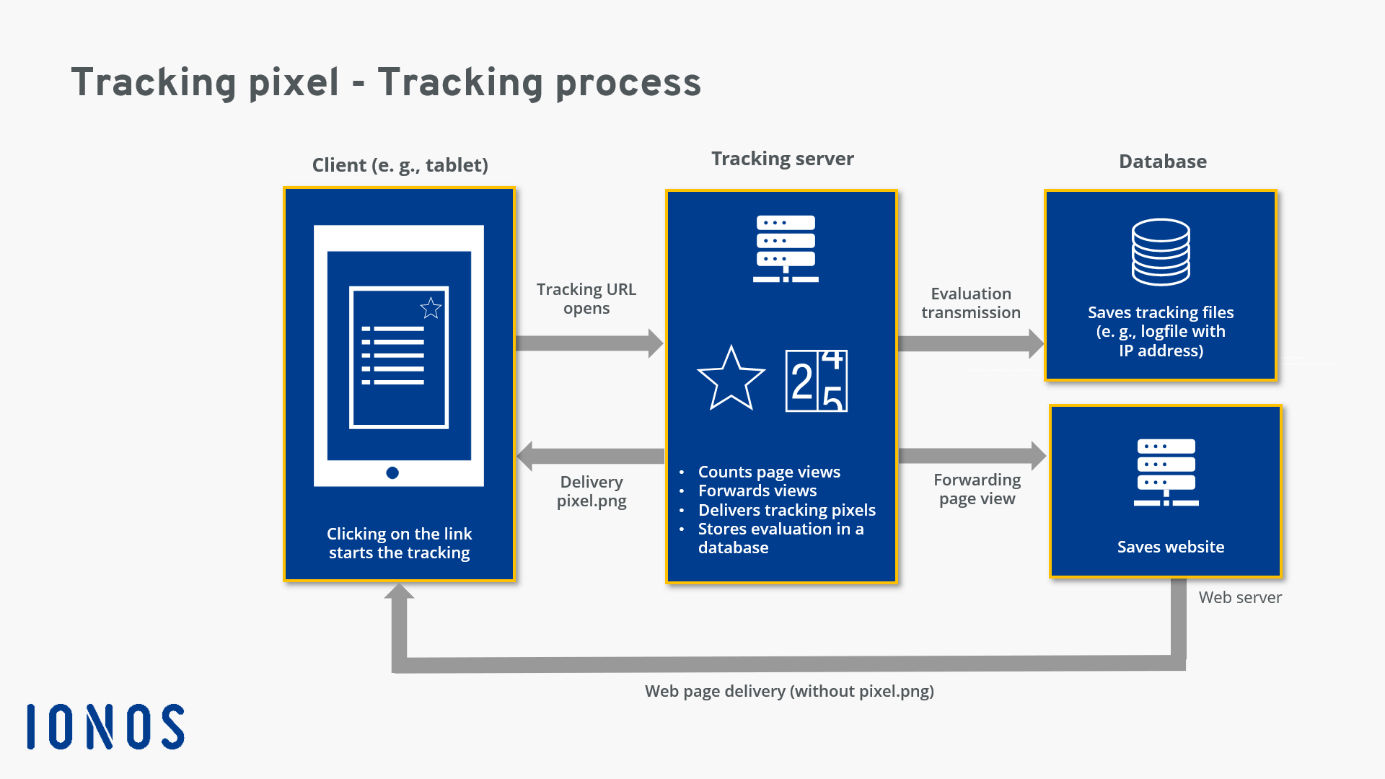Tracking pixel – online tracking made easy
Tracking pixels have played a key role in online marketing for years, as they provide reliable data about user behaviour which in turn enables tailored advertising and sales campaigns, for example. Their implementation in websites and emails is not particularly complicated. Regarding data protection, however, it’s essential that companies track users in a GDRP-compliant manner, as they could otherwise face sanctions and fines.
Register a domain name
Make your project a success with the perfect domain extension.
What is a tracking pixel?
In online marketing, a tracking pixel is defined as a graphical element that is embedded in the code of web pages, online advertising, or emails. It is usually only one pixel wide and one pixel high and is therefore also called 1x1 pixel or a one-pixel image. Due to its small size, the tracking pixel does not slow down the loading times of emails, advertisements, and web pages. Other common names for the tracking pixel include counting pixel, pixel tag, on-site or website pixel, pixel method, clear GIF, web bug, or web beacon.
Tracking pixels are usually colourless and transparent, which is why they’re also commonly referred to as a ‘clear GIF’ und cleverly perform their work in secret. In the context of networked backend processes that exclude user experience, tracking pixels are commonly used in online marketing as well as in e-commerce with the collection and evaluation of user data. Among other things, tracking pixels provide companies with information about the reach of online and email marketing efforts, enabling them to optimise their sales and marketing strategies.
Strictly speaking, pixel tags are used to count website visits. However, when a tracking pixel is retrieved, other data is also acquired and stored in the log files of servers. The pixel request can also trigger the setting of cookies, which play an equally significant part in the tracking process. In combination with cookies and other tracking methods, tracking pixels are involved in the obtaining of many kinds of bits of information:
- Type of browser and version
- The operating system being used
- The device being used (e.g., a mobile phone or desktop computer)
- The client being used (e.g., a browser or a mail program)
- Screen resolution
- Referrer URL (the site address that the user visited to lead him to the address with the tracking pixel)
- IP address for inferences about the Internet Service Provider (ISP) and location. Location data provides the basis for geo-targeting
- Data on the customer journey (Among other things, the use of multiple tracking pixels documents how users navigate an entire website, what they search for, and which links and ads they click on)
- Data and time of a server request (triggered by calling up an email or web page)
- The opening, opening time and forwarding of emails
- Click rate (link tracking)
- Time and date of a page view (including a description of the page on which the tracking pixel is located. This allows transactions in affiliate marketing to be assigned, for example)
Since this and other data can be collected across servers and pages, modern tracking provides a comprehensive picture of the surfing, shopping, and consumption behaviour of website visitors.
How do tracking pixels work and which web analytics tools do they work with?
For tracking pixels to do their job, the source code of a web page or an email must be adapted accordingly. A simple HTML code snippet ensures that the tracking pixel is loaded from a specific address when the page is called up (tracking pixel URL) and is provided with the characteristic display size (1x1 pixel), for example. You can also set the values for the width and height to ‘0’ to suppress the display of the tracking pixel altogether:
img src="Tracking-Pixel-URL" width="1" height="1"The visual appearance of modern web pages is defined more precisely with special style sheets called cascading style sheets (CSS). The style attribute ‘visibility:hidden’ defines that a tracking pixel should be hidden. The CSS attribute ‘position:absolute’ causes the pixel tag to be completely removed from the normal flow of the page layout:
img src="Tracking-Pixel-URL" style="position:absolute; visibility:hidden"img src="Tracking-Pixel-URL" style="display:none"The building blocks of code can be manually implemented into the source code of a website by way of page tagging. If you’re using a content management system, then tracking pixels can also be easily configured and integrated with a plugin. For WordPress, for example, you can use the Pixel Tag Manager PixelyourSite - Homepage of WordPress Plugin">PixelyourSite specifically for this purpose.
Modern tracking often works with more complex code. For example, the use of JavaScript makes it possible to trigger the tracking pixel with script and to find out even more about the user and the software and hardware used. The classic HTML integration of website pixels is then usually part of a double strategy: with so-called JavaScript tags, one first tries to implement the best tracking and data collection. If this method does not work (for example, due to the use of script blockers in the user’s browser), the simple HTML code for triggering tracking pixels is used as an alternative and ensures the transfer of important tracking data. In this case, the tracking pixel is embedded in a special tag (<noscript>), which is processed by the reading browser when JavaScript is disabled. Facebook, for example, uses this type of ‘plan B code’ when integrating the so-called Facebook Pixel:
<noscript></codesnippet></noscript>
<img height="1" width="1" style="display:none" < codesnippet>
src="https://www.facebook.com/tr?id={here is the pixel ID}&ev=PageView&noscript=1"/>There are other encoding variants of tracking pixels. In affiliate marketing, IDs (store IDs or order IDs) and other parameters (total value/sales) are often appended to the tag to be able to assign the individual transactions during billing and to communicate relevant purchase data in the affiliate network. In the following example, the tracking pixel is triggered via the price search engine Kelkoo:
<img< codesnippet></img<>
src=" https://www.kelkoo.us.com?shop_id=SHOP-ID&oid=ORDERID&val=TOTAL-VALUE" width="1" height="1"
/>A tracking pixel is triggered (in the industry the process is also called ‘firing’) when, for example, an online store page is opened by mouse click and loaded in the browser (e.g., Google Chrome). Among other things, the browser reads the code snippet for the tracking pixel and requests the thumbnail image via the tracking pixel URL. The addressed server then sends the pixel tag to the client’s browser, counts the page view, and logs the recipient’s unique IP address and other visitor information sent during the request procedure in log files. These records are then used for quantitative (statistical) and qualitative analysis in online marketing.
For the evaluation, web analytics tools are used. The best-known tools and services of this kind include Google Analytics, etracker, and the open-source web analytics platform Matomo (formerly Piwik). Facebook customers feed the tracking data to the analysis tool Facebook Pixel using a corresponding embed code. In email marketing, counting pixel data can be analysed with the following tools: MailChimp, Newsletter2Go, CleverReach, GetResponse, as well as Campaign Monitor. Some of these tools also work together with Google Analytics.
Nowadays, it’s common to use a special technical infrastructure for the collection and recording of user data. For example, a special third-party server (tracking server) is often connected in between, through which links are redirected. This server collects all relevant tracking data for reporting purposes. In many cases, a separate database is used to store and maintain these massive amounts of collected data.

Advantages and disadvantages of tracking pixels
Tracking pixels offer many advantages to those using them. They deliver valuable data on user behaviour, on-page traffic, on-page performance, and can be used for the optimisation of online strategies and advertising campaigns. Webmasters and web designers can use this data to improve page performance and the page layout of online offers and shops. Social media activities and search engine optimisation (SEO) also benefit from tracking technology: In combination with web analysis tools such as Google Analytics and Facebook-Pixel, a broader database and with that deeper insights into important marketing and customer insights can be generated. Targeting methods in marketing are a further field that greatly benefit from the solid data provided by pixel-based tracking, since scattering loss is kept to a minimum when reaching target groups. In addition, the placement of advertising elements on websites or in search engines can be successfully targeted.
Tracking pixels are particularly efficient in supporting sales and e-commerce strategies, as tracking pixels enable the customer journey to be traced. If on-site pixels are placed on all pages of an online store, the activities of individual customers can be recorded without gaps. So-called ‘conversion pixels’ are placed on strategically important pages that customers can only access after registering or after making a purchase (e.g., on the thank you page after the purchase). These kinds of website pixels can be used to reliably measure whether and how often customer interest leads to a product purchase (sales conversion).
Since success and failure can be concretely measured for practically all pages of an online store, the use of website pixels can be an important step towards conversion rate optimisation. Continuous and ongoing customer tracking can very precisely identify jumping-off points in the customer journey and weaknesses in the design of the user experience and in the usability of a web offering.
In addition, pixel-based tracking can also gain information that is helpful when it comes to selecting advertising media and in selecting the appropriate advertising contexts. In addition, it can improve customer acquisition and support the generation of leads (leads are the initiation of contacts).
By analysing the tracking data, the customer journey can be visualised in the form of a customer journey map and the interactions between customer and brand can be illustrated. This is valuable information for companies, allowing them to analyse and assess their sales and marketing activities from the perspective of their customers.
Besides the relatively straightforward implementation and deployment of simple pixel counting, further technical advantages include the fact that the triggering of tracking pixels on web pages, emails, and ads works even when JavaScript is blocked. In addition, a tiny pixel tag has almost no impact on the page loading time of a website.
However, you shouldn’t overdo the use of tracking techniques. For example, if you use numerous marketing pixels for different purposes, this can slow down the loading of a page. That’s because the browser communicates with different software interfaces and servers when the page is called up, which should be easily accessible and not overloaded at that moment. Performance can also be adversely affected if tracking tools from several providers are used simultaneously (e.g., Google Analytics, WP-Statistics, Facebook Pixel).
Often delays are the result of the incorrect implementation of tracking pixels and JavaScript tags in the source code. If you use a special plugin for tracking in the CMS, it should be proven and performance-optimised, otherwise it may take too much time to load and trigger the pixel tag. One of the disadvantages of the tracking method is that the triggering of tracking pixels is prevented by blocking images. This option is more often used on mobile devices to reduce the data traffic of volume tariffs and save costs.
Unfortunately, tracking pixels are also commonly misused and implemented into spam emails, to check on email addresses. When a user opens a spam email, the tracking pixel is loaded, and the email address is marked as valid and registered within the hacker network. Now, more and more unwanted spam and phishing emails can reach the verified account. In addition, when pixel-based counting technology is used, targeted manipulations can take place, e.g., through visitor exchange systems or click software.
Tracking pixels and data security
Since you’re documenting and following user behaviour, tracking technology has long been a point of criticism for data protectionists. Coupled with the need for GDPR compliancy, which was implemented in the EU in 2018, a very high data protection standard is now required by international standards. Data protectionists criticise that tracking pixels operate unnoticed in the background and aren’t visible to the user. In addition, the scope of the collected data and its further processing is not something users are made aware of.
Tracking that does not collect data anonymously and establishes a clear personal reference without the knowledge and explicit consent of the user is rated as particularly problematic. This is the case, for example, when email newsletters are sent with counting pixels and a direct personal reference can be established via the private email address and an individually assigned tracking ID. Tracking becomes even more questionable from the point of view of data protectionists when additional tracking techniques such as cookies contribute to the comprehensive profiling of users, and data from different sources is combined (for example surfing behaviour combined with social media data).
The transfer or selling of personal data to third parties for additional evaluation or marketing purposes is a step into a legal grey zone, especially when US-based corporations like Facebook (Facebook Pixel) or Google Analytics are involved. In the US, investigating authorities, intelligence agencies and the state can access user data at any time.
To avoid sanctions and fines, companies should always operate in compliance with the GDPR and process data securely and without any personal relation (anonymously or by using pseudonym techniques). If tracking methods are still being used that are critical to obtaining personal data, companies and store operators should consider putting a GDPR-conform consent tool in place to obtain explicit consent.
In this context, a so-called ‘opt in’ requirement has also been stipulated for advertising and marketing cookies.
In addition, a passage on tracking pixels should be included in the privacy policy of your website. Considering the surprising end of the Privacy Shield, companies will be held more accountable and – if they want to avoid sanctions – must now be more actively involved than ever in the discourse on data protection. In terms of web analytics services, the German company etracker is advertising GDPR compliant tracking without an opt-in obligation.
Online, further recommendations and code modules have been circulating, for example for anonymising IP addresses when transmitting tracking data to Google Analytics. However, it’s questionable whether such recommendations will stand the test of time. Since the legal situation is dynamic and complex, and the GDPR-compliant nature of websites and online stores is increasingly being reviewed, companies should not take any risks when using tracking techniques and should consult with a data protection expert if in doubt.
If users want to actively protect themselves from tracking, they can install appropriate browser plug-ins – for example, to block JavaScript – and adjust the browser’s security settings so that cookies are completely blocked or only temporarily allowed. By deactivating images all together in mail programs and browsers, you can effectively protect yourself from tracking pixels, but will have to accept restrictions in the display of mail and web pages. You can be more flexible if you make the loading and display of images dependent on your consent. In this case, however, each individual case must be checked. In mail programs, it’s possible to disable support for mails in HTML format and prevent the download of tracking pixels. Proxy servers or the Tor Browser can also be used to avoid tracking pixels and prevent entries in server log files.
Please note the legal disclaimer relating to this article.
Professional Email Address & Personal Domain Name
Give the right first impression with a custom email address and a free matching domain name!







